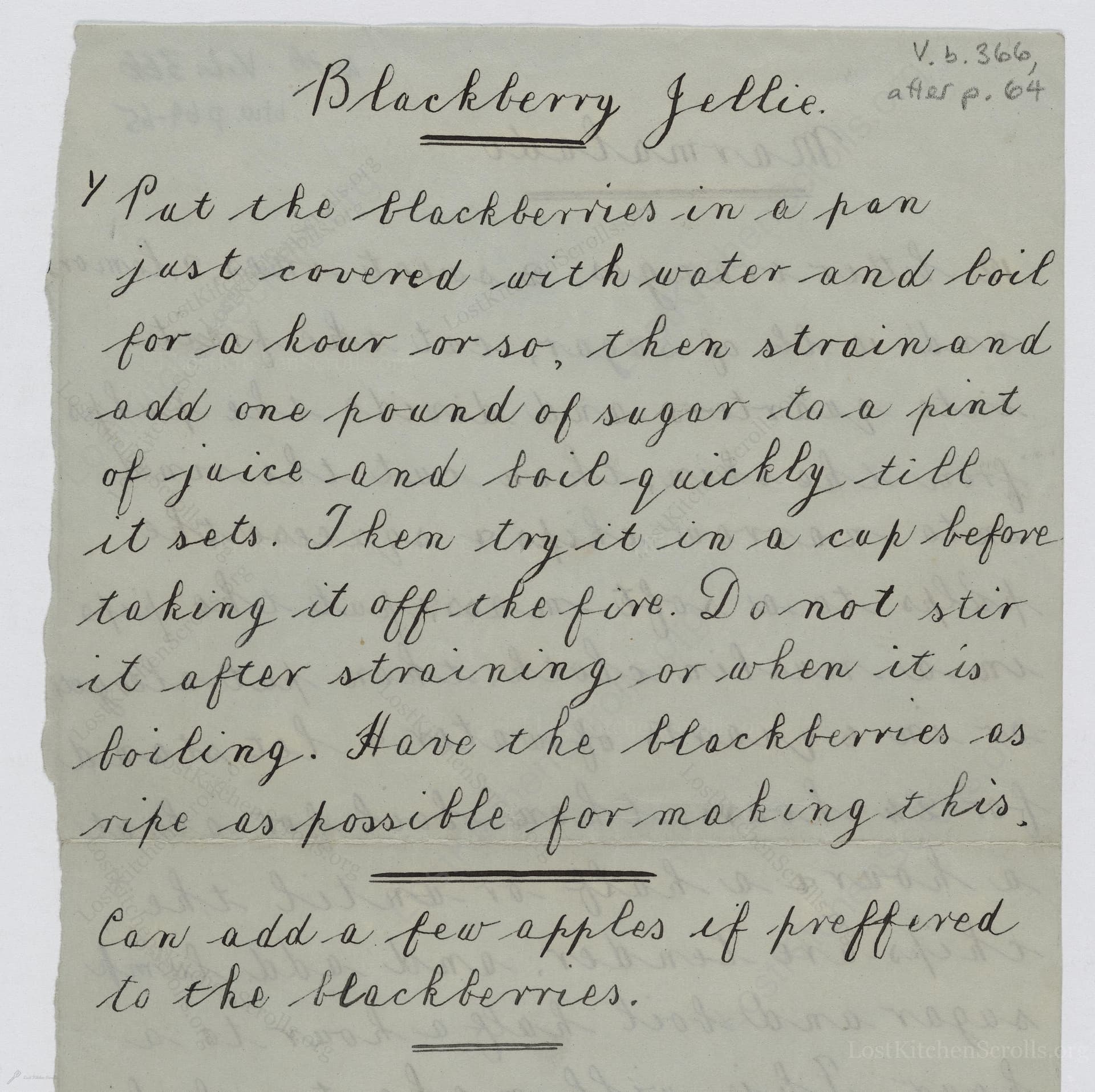Blackberry Jellie
From the treasured pages of Receipt book of Rebeckah Winche
Written by Rebecca Winch

Blackberry Jellie
"Y Put the blackberries in a pan just covered with water and boil for a hour or so, then strain and add one pound of sugar to a pint of juice and boil quickly till it sets. Then try it in a cup before taking it off the fire. Do not stir it after straining or when it is boiling. Have the blackberries as ripe as possible for making this. Can add a few apples if preffered to the blackberries."
Note on the Original Text
The recipe is written in the instructive, narrative form common before the widespread use of printed cookbooks. Quantities adapt to whatever juice yield you achieve. The phrasing reflects a domestic context: methodical, detail-light, relying on the cook's intuition. Spelling and word choices, like 'Jellie' for 'jelly' and 'preffered' for 'preferred,' are characteristic of 17th-century English and mild manuscript idiosyncrasy. The physical process—boiling, straining, and set-testing—remains much the same today, bridging past and present culinary practice.

Title
Receipt book of Rebeckah Winche (1666)
You can also click the book image above to peruse the original tome
Writer
Rebecca Winch
Era
1666
Publisher
Unknown
Background
Step into the 17th-century kitchen with Rebecca Winch, where hearty feasts and time-honored recipes whisper secrets of early English cooking. From savory pies to delicate sweets, this charming volume offers a sumptuous glimpse into culinary history.
Kindly made available by
Folger Shakespeare Library
This recipe for Blackberry Jellie comes from Rebecca Winch, an Englishwoman active in the mid-to-late 17th century. Preserving fruits in the form of jellies and jams was a key part of domestic management, especially before refrigeration. Using ripe blackberries, sometimes supplemented with apples for their setting properties, was a seasonal tradition tied to rural English kitchens. Recipes like this circulated in household manuscripts and were tailored to what could be foraged or grown. The careful not stirring and the set-test in a cup are heirlooms of an era before kitchen thermometers or commercial pectin, rooted in lived tradition.

In the 17th century, this preserve would have been made in a heavy brass or copper preserving pan set over a wood or coal fire. A muslin cloth or fine sieve would be used to strain the juice, and simple wooden spoons or paddles for minimal stirring. Porcelain or earthenware cups and shallow plates served to check if the jelly had set. Glass jars or ceramic pots, sealed with parchment or wax, completed the process.
Prep Time
15 mins
Cook Time
1 hr 15 mins
Servings
30
We've done our best to adapt this historical recipe for modern kitchens, but some details may still need refinement. We warmly welcome feedback from fellow cooks and culinary historians — your insights support the entire community!
Ingredients
- 3.3 lb ripe blackberries
- 1 pint water (enough to just cover berries)
- 1 lb granulated sugar per 1 UK pint (20 fl oz) blackberry juice
- Optional: 7–10 oz tart apples (such as Bramley or Granny Smith), cored and chopped
Instructions
- To make Blackberry Jelly in a modern kitchen, begin with sourcing ripe blackberries—about 3.3 pounds for a standard batch.
- Place them in a large saucepan and just cover with water (roughly 1 pint).
- Bring to a boil and simmer gently for about an hour.
- Once the fruit has broken down, strain through a fine-mesh sieve or cheesecloth without pressing, to collect the juice.
- Measure out your juice; for every 1 UK pint (20 fluid ounces) of juice, add 1 pound of white granulated sugar.
- Return the juice and sugar mixture to the cleaned pan and bring rapidly to a boil, skimming any froth that appears.
- Do not stir after the sugar is dissolved.
- Continue boiling until the mixture reaches the setting point (usually 219°F, or until a small amount gels on a chilled plate).
- Remove from heat, test again for set, then pour quickly into sterilised jars.
- Optionally, tart apples (about 7–10 ounces, cored and chopped) may be added during the initial simmer to increase pectin and aid setting.
Estimated Calories
50 per serving
Cooking Estimates
It usually takes about 15 minutes to prepare the fruit, wash it, and set up your workspace. Cooking and boiling the blackberries to extract juice then making the jelly usually takes about 1 hour and 15 minutes. This recipe makes about 6 jars, which is about 30 servings, with around 50 calories per serving.
As noted above, we have made our best effort to translate and adapt this historical recipe for modern kitchens, taking into account ingredients nowadays, cooking techniques, measurements, and so on. However, historical recipes often contain assumptions that require interpretation.
We'd love for anyone to help improve these adaptations. Community contributions are highly welcome. If you have suggestions, corrections, or cooking tips based on your experience with this recipe, please share them below.
Join the Discussion
Rate This Recipe
Dietary Preference
Main Ingredients
Culinary Technique

Den Bockfisch In Einer Fleisch Suppen Zu Kochen
This recipe hails from a German manuscript cookbook compiled in 1696, a time whe...

Die Grieß Nudlen Zumachen
This recipe comes from a rather mysterious manuscript cookbook, penned anonymous...

Ein Boudain
This recipe comes from an anonymous German-language manuscript cookbook from 169...

Ein Gesaltzen Citroni
This recipe, dating from 1696, comes from an extensive anonymous German cookbook...
Browse our complete collection of time-honored recipes



